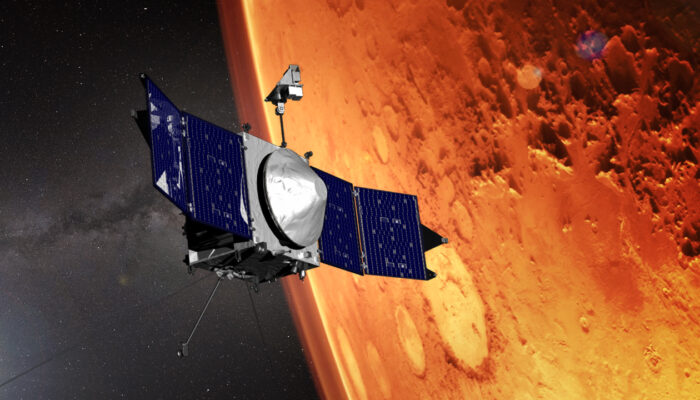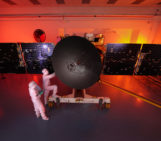
One of the realities of studying the Earth, planetary or space sciences is that we are attempting to observe an experiment that has been in progress for billions of years, with variables that are most often far outside of our control. Many researchers try to understand these systems by recreating aspects of it, either in analogue experiments or by using simulations, where the variables can be adjusted or removed intentionally. So you can understand the excitement of the Mars Atmosphere and Volatile Evolution (or MAVEN) team, when, on Christmas morning 2022, one of the variables impacting the Martian atmosphere that they were observing, the solar wind…. disappeared, creating a once-in-a-lifetime experimental condition.
The MAVEN mission is the first mission specifically gathering data on the Martian upper atmosphere, in an attempt to understand how the changes in the upper atmosphere, namely the loss of atmospheric gases to space, impacted the development of the Martian climate by asking the question: “Where did the atmosphere—and the water—go?” The mission is co-organised by the University of Colorado, Boulder’s Laboratory for Atmospheric and Space Physics (LASP), the University of California, Berkeley’s Space Sciences Laboratory (SSL), and NASA’s Goddard Space Flight Center (GSFC).
In an announcement shared during the AGU’s 2023 Fall Meeting last week, the lead researchers on the project Jasper Halekas, Skylar Shaver, Yingjuan Ma, and Shannon Curry described what caused the solar wind to ‘disappear’ for two days and the impact it has had on their study. The cause of the observed disappearance of the solar wind wasn’t because the wind (a supersonic flow of hot ionized gas) actually disappeared, but because one faster ‘stream’ of wind overtook a slower one preceding it, creating a void or low-density area, behind the space where the two winds converged. This meant that the observations gathered by the MAVEN satellite over the two days that the void was passing by Mars were unique compared to the others gathered in the last 10 years of the mission’s observations: for the first time, there was no solar wind impacting the planet. The reaction of the atmosphere was dramatic. As Skylar Shaver described it “the Martian system was able to expand into the void where the winds overtook each other… and the ionosphere expanded to over three times its typical extent.”
The observations gathered during this time were especially important as the Sun’s activity increases towards the solar maximum of the current solar cycle, which is already much more active than the previous cycle, as solar activity has a very significant impact on Martian and other inter-planetary exploration. But it wasn’t just the size of the atmosphere that changed in response to the solar wind being briefly “turned off” as Jasper Halekas described it. Yingjuan Ma explained that the decrease in pressure also briefly changed the atmosphere’s shape, as the expansion was asymmetric and dynamic, as well as distinctly affecting the bow shock, the magnetosheath and the magnetosphere of the planet.
The observations also help us understand the changes to Mars’ past climate. As MAVEN principal investigator Shannon Curry explained, “Atmospheric pressure is needed for stable liquid to form. As the [Martian] atmosphere was lost to space, the pressure was removed.” This loss of pressure could have led to the fluid water on Mars to return to a gaseous form and also be lost to space with the other atmospheric gases. The MAVEN mission aims to learn more about exactly how this process may have happened, and the way that big solar storms eroded the Martian atmosphere over time. “Observing extreme conditions is always scientifically invaluable,” Curry commented. “MAVEN was designed to observe these types of interactions between the Sun and the Martian atmosphere, and the spacecraft provided exceptional data during this truly anomalous solar event.”
Beyond the data collected and the insights gained, this was an exceptionally rare instance of being able to remove a variable in an active and ongoing part of our complex Universal system – in the same way that we usually rely on simulations to achieve. As researcher Jasper Halekas put it “This was a Christmas present for us; Nature set up this perfect science experiment.”
Read the paper: The Day the Solar Wind Disappeared at Mars (2023) JGR Space Physics




